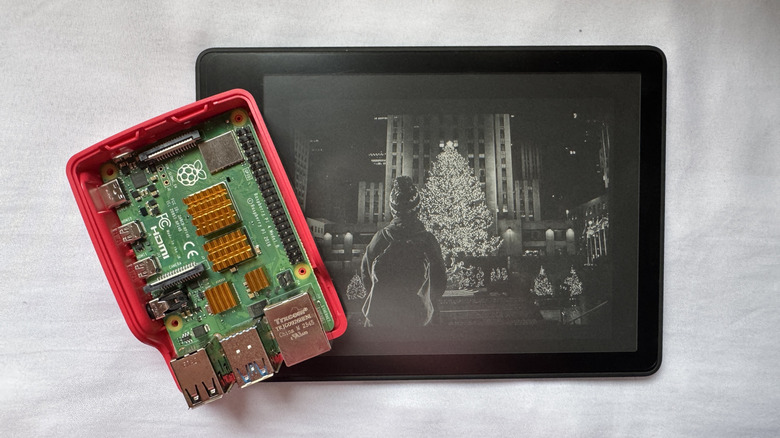6 Raspberry Pi Christmas Projects To Get You Into The Festive Spirit
As a Raspberry Pi enthusiast, chances are you've already built a ton of projects with your board. Perhaps you've tried making your own Raspberry Pi media center, or a retro gaming machine, or maybe even a parking sensor and door monitor for your garage. With this single-board computer's versatility, the possibilities are endless.
You might not, however, have thought about using your Raspberry Pi for enhancing your space during the festive period. Sure, it's a great tool for all sorts of practical projects around the house, but it can also be the perfect brain behind some electronic decor. And since Christmas is fast approaching, there's no better time to put your Raspberry Pi to work than as part of your holiday setup. We'll cover six of the classic Christmas projects you'll want for the Yuletide season — each made with a Raspberry Pi to bring a more techy twist to your decorations.
Christmas light show controller
Nothing screams holiday cheer more than some festive Christmas lights decorating the front of your home. But just plain blinking lights can quickly get boring. If you want something more impressive and fun to watch, put on a Christmas light show powered by Raspberry Pi instead.
To make this nifty project, you can use the open-source software LightShow Pi. LightShow Pi is specifically developed for syncing lights to music and can do all of the heavy lifting for you. Once it's installed, all you have to do is access the Pi remotely via SSH and run the terminal command to activate the project. LightShow Pi will then use your custom music to dictate which relay in your multi-channel relay board to turn on and off at certain times (each relay is connected to one string of lights). The end result is a fancy light show perfectly synced to your music of choice.
With its simplicity, this is the perfect Pi project for beginners to do on a weekend. It's also a good way to practice your Linux skills, as you'll mostly be working with terminal commands. You can find tutorials on how to use the LightShow Pi from the official website and via the active Reddit subreddit – which has been designated as the official support forum since 2018. One pro tip, though: make sure to set up the Pi to automatically run your terminal commands upon boot. Otherwise, you'll need to have your computer turned on with the SSH terminal open all the time to keep the light show running.
Shake-activated gift box
Unwrapping gifts on Christmas is arguably one of the highlights of the day. But instead of just letting the recipients tear off wrapping papers like usual, why not add a fun little twist by putting the items in a shake-activated gift box?
The premise of this Raspberry Pi-powered project is simple: the recipient needs to "shake" (or more accurately, tilt) the box to unlock it. However, you can't just tilt it any way you want — it needs to be done in the correct directions (up, down, left, right) in the correct sequence, like a shake password of sorts. The direction of the tilts is detected by a BMX160 9-axis sensor module tucked inside the box. Once it determines that a direction is correct, it activates the vibration motor module (also inside the box) for a short moment to notify you that you're on the right track. After you guess the right order of directions, the 180-degree micro servo, which serves as the box's lock, moves to the side to allow you to open the box. To customize the project with your preferred combination of directions, all you have to change in the code is the password entry.
Minus the Pi and the power supply, the parts for this project won't cost you more than $20, so it's a Christmas-themed Raspberry Pi project that's easy on your wallet. Just a word of caution: make sure not to use the gift box for fragile items, like snow globes, perfume bottles, and china sets.
Christmas song player
Christmas morning isn't just for opening gifts — it's also the perfect time for playing games like Christmas charades, Pictionary, and Mad Libs. But probably one of the most popular and easiest holiday-themed games to play is the classic Name That Tune. It's simple enough for the game master to set up and the players to understand. However, the usual way of playing an instrumental version of the song on YouTube can make guessing a bit too easy. If you want to up the challenge, build this Christmas song player instead.
It's a Raspberry Pi Pico project that uses only one other component: a piezoelectric buzzer. The tunes are played through the buzzer, and since the tones produced aren't as clear and high-quality as they are on a regular speaker, players really have to listen closely to properly recognize the song. The beauty of this project is that it's also quick and easy to build, with only two components to wire up. The hard part, though, is writing the MicroPython code. You might have to spend some time finding the correct tone sequence for your chosen Christmas carols and then converting these tones to the right frequencies for the buzzer. Lucky for you, this project isn't too niche, so you can easily find tutorials and tone libraries online to help you.
You can also upgrade the project and try connecting an I2C LCD screen to the Pico. Then, after playing a song, it can display the title for everyone to see.
Slow Christmas movie player
Christmas movies have a special way of filling the air with festive vibes. But let's be real — you won't want to keep your TV on all the time (hello, high utility bill!), so this slow Christmas movie player is a great alternative. It's a cool project you can do with a Raspberry Pi and a display, all with minimal energy cost.
At first glance, the project looks like any regular digital picture frame, with the photos changing every couple of seconds. However, these aren't just random pictures; they're actually frames from a Christmas movie, playing in sequence. Think of it like a video playing out in super slow motion. The project is based on the SlowMovie project on GitHub, with software that automatically reads the MP4 files in a specific folder, extracts the frames from the video, scales the frames to fit the display's resolution, and then shows the frames one at a time with a set delay in between.
The program also allows customizations. By just adding an argument to the original CLI command, you can set the program to do several things, including looping through a single video, playing the videos in random order, changing the delay between the frames, going full screen, displaying subtitles or the video timecode, and adjusting the image contrast. Hardware-wise, the project only requires the Pi, an e-ink display, the e-ink display HAT for the Pi, a power supply, and, optionally, a frame to make the display more picture frame-like.
Retro TV holiday ads ornament
Nostalgic TV holiday ads bring a different sort of charm. Remember those classic Oreo commercials with Santa? Or the ever-iconic M&M's "They do exist!" ad? How about the Hershey's Kisses ringing like bells and playing "We Wish You a Merry Christmas"? If you want to make these nostalgic TV holiday ads a part of your decor, a Raspberry Pi-powered TV ads looper might just be what you're looking for.
For this project, you'll only need your Pi board and a display for the hardware and Adafruit's pi_video_looper for the software. The program automatically reads the video files from a connected USB stick or internal storage, and play them over and over again. You can specify the timing, and there's also an option to map the GPIO pins of the Pi to a specific action, such as skipping to the next video.
There's also a premade video looper image file available for use. Just simply install the image file to the microSD card and you're good to go. One thing to keep in mind is that the pi_video_looper project only works on Buster Lite (specifically the 2022-01-28 version or earlier). Since this is not available in the Raspberry Pi Imager, you'll need to download the image yourself. Buster's support also ended in June 2024. That means it's no longer receiving updates, so avoid connecting your Pi to the network to minimize security risks. The project can run on Raspberry Pi 4 and older models. You can't use the Pi 5 since it's only compatible with the newer Bookworm release. If you're using a Pi 3A+, Adafruit requires you to copy over some firmware files to your boot folder to ensure everything works as expected.
Ugly Christmas sweater
If there's one Christmas tradition that's as constant as putting up the tree, it's holding ugly Christmas sweater competitions. Every year, everyone tries to outdo one another with the tackiest and most ridiculous sweater of all. But instead of gluing on ornaments and glitter, make your ugly Christmas sweater truly over the top with a Raspberry Pi.
This project makes LEDs attached to the sweater flash in patterns that sync with the rhythm of the music playing. So, it's essentially a wearable Christmas light show that you can parade around the house or office. The system analyzes the songs in a specific folder in the Pi, creates a pattern for the LEDs based on the frequency ranges in the songs, and then plays the songs through a Bluetooth speaker. For controls, there are two switches built into the sweater: one for pausing and resuming the music and another for playing and switching to the next song.
For this project, you'll need a Raspberry Pi and Adafruit 24-Channel 12-bit PWM LED Driver to control the LEDs, which, in turn, are made up of Adafruit LED Sequins in ruby red and Adafruit Flora RGB Smart NeoPixel. A logic level shifter and breadboard are also required — the shifter for converting the Pi's 3.3V logic to the NeoPixels' 5V logic and the breadboard to easily connect the components together. The entire system is then powered by a battery pack for portability. Speaking of portability, due to the Pi's size, it has to go outside the sweater, which can make the project a bit clunky.

